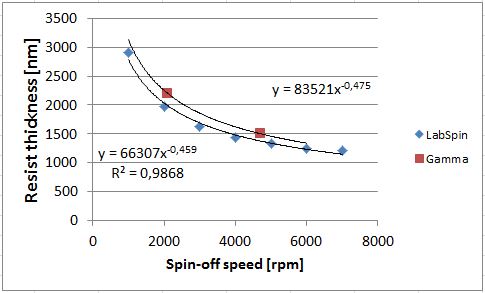Specific Process Knowledge/Lithography/5214E
This section, including all images and pictures, is created by DTU Nanolab staff unless otherwise stated.
Feedback to this page: click here
Resist description
AZ 5214E is a positive UV photoresist with image reversal capability. It is considered to have good adhesion when wet etching.
Spin coating
Typical spin parameters:
- Spin off: 30-60 s
- Soft bake: 60 s @ 90°C
Image reversal
Typical image reversal parameters:
- Reversal bake temperature: 110°C
- Reversal bake time: 60 s
- Flood exposure: 500 mJ/cm2
If 5214E is baked after exposure, the exposed resist will cross-link, making it insoluble in the developer. This is called the "Reversal bake". The reversal bake activates cross-linking of the exposed areas, which "reverses" the polarity of the design. When the substrate is flood-exposed after the reversal bake, the previously unexposed areas become soluble, and will be removed in the subsequent development. The image reversal procedure effectively makes AZ 5214E a negative resist.
The image reversal process greatly increases the sensitivity of AZ 5214E, and the dose of the image exposure is a critical parameter, especially if negative angled resist sidewalls are desired.
Half dose of the normal, positive process is a good starting point for optimization. Similarly, the reversal bake is also a critical step, and must be tightly controlled in order to achieve consistent results. If negative sidewalls are desired, 60 - 120 s at 110°C is recommended (as well as a resist thickness above 2 µm), but if straight sidewalls are desired, 60 - 120 s at 120°C can be used.
The flood exposure, on the other hand, is uncritical, and ~5 times the normal positive process dose is generally used.
Development
Development speed:
- Puddle development in 2.38% TMAH (AZ 726 MIF): ~2 µm/min
